Mastering the Craft of Peanut Butter Cookies
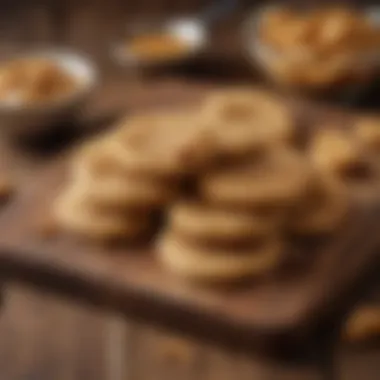
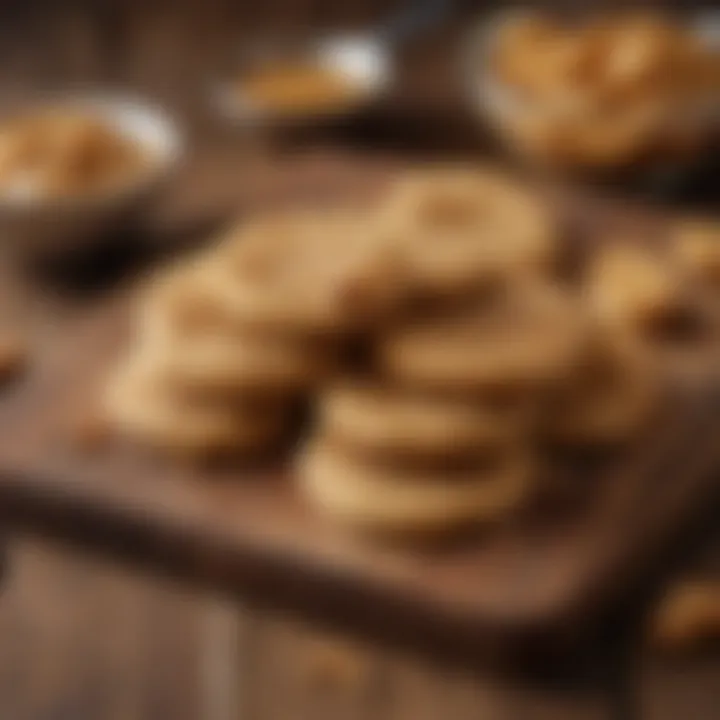
Recipe Highlight
When it comes to baking peanut butter cookies, the Ultimate Creamy Peanut Butter Cookie is a title that speaks for itself. This recipe showcases the rich and nutty flavors of peanut butter while delivering a delightful chewy texture that keeps you coming back for more.
Essential Ingredients
- 1 cup creamy peanut butter
- 1 cup granulated sugar
- 1 large egg
- 1 teaspoon vanilla extract
- 1/2 teaspoon baking soda
- A pinch of salt
Estimated Time
Preparation time is approximately 10 minutes, and baking takes around 10 minutes. So, you’re looking at a total of about 20 minutes from start to finish.
Serving Yield
This recipe yields about two dozen cookies, perfect for sharing or enjoying over a few days.
Step-by-Step Instructions
- Preheat Your Oven: Set your oven to 350°F (175°C) and prepare your baking sheets by lining them with parchment paper.
- Mix Ingredients: In a large bowl, combine the peanut butter, sugar, and egg. Stir in the vanilla extract, baking soda, and salt until the mixture is smooth and well incorporated.
- Scoop and Roll: Using a tablespoon or cookie scoop, portion out the dough. Roll each piece into a ball and place them on the baking sheet, spacing each cookie about two inches apart.
- Flatten with Fork: Lightly press each ball with a fork, creating a crisscross pattern that not only looks nice but also helps with even baking.
- Bake: Place the baking sheet in the preheated oven and bake for 8 to 10 minutes. You'll want them to start turning golden but not completely firm, as they will continue to firm up outside the oven.
- Cool Down: Allow cookies to cool on the sheets for a few minutes before transferring them to a wire rack.
Cooking Techniques
Consider using room-temperature ingredients to bring out the best in flavor. If you find the dough a tad too sticky, you might sprinkle a little flour, but be cautious; you want that peanut flavor singing strong.
Insider Tips
One common mistake is overbaking. Trust your instincts; those cookies should feel slightly soft when they come out. They’ll catch up while cooling, resulting in that desired chewy texture.
Variations and Substitutions
If by chance you are looking to switch things up, there are plenty of options:
- Nut Butters: Swap in almond butter or cashew butter for a unique spin on the flavor.
- Sweeteners: Consider using brown sugar or honey to deepen the flavor complexity.
- Additions: Toss in chocolate chips, chopped nuts, or dried fruit for added texture and taste.
Ways to Enjoy
These cookies hold well just on their own, but serve them warm with a glass of milk for the ultimate treat. You can even crumble them over ice cream to make an indulgent sundae.
Time-Saving Cooking Tips
Preparation doesn't have to be a hassle:
- Prep Ingredients Ahead: Separate your ingredients and measure them out before starting to cook. This makes everything flow smoother.
- Quality Tools: A cookie scoop saves you time and ensures even cookie sizes, which means even baking.
- Batch Baking: Mix double the dough and freeze half for a quick bake later on. Just thaw and bake when the cookie urge hits!
Nutritional Information
Each cookie, based on the recipe, contains approximately 95 calories.
- Key Nutrients: These cookies provide a healthy dose of protein, healthy fats, and since they’re made with simple ingredients, they’re free of artificial additives.
- Diet Suitability: Easily adaptable for gluten-free by substituting for gluten-free flour, and it's naturally free from dairy. A nod to the vegans might be found here too if flax eggs are used instead of real eggs.
"The beauty of peanut butter cookies lies not only in their delightful taste but also in their flexibility to cater to various dietary needs, making them a favorite among many."
Explore the depths of flavor and texture through these cookies, and elevate your baking skills to new heights.
Understanding Peanut Butter Cookies
Peanut butter cookies aren’t just another sweet treat; they are a delightful amalgamation of flavor, culture, and nostalgia that resonates with many. The significance of understanding these cookies goes beyond merely baking them. It encompasses their historical roots, cultural relevance, and the distinct qualities that make them a beloved classic.
When one delves into the world of peanut butter cookies, it's apparent that they hold a cherished place in the hearts of food lovers. The comforting aroma wafting from the kitchen as they bake can evoke memories of family gatherings or quiet afternoons spent with a glass of milk.
Historical Context
The origins of peanut butter cookies can be traced back to the United States in the early 1900s. Initially, peanut butter itself gained popularity with the rise of commercially produced spreads, making it accessible to households across the nation. By the 1930s, these cookies began to appear in cookbooks, signaling their entry into American culinary tradition.
Interestingly, the peanut butter cookie's rise seems to align with the growing availability of peanut butter brands, notably J.M. Smucker, whose products helped popularize the ingredient. It’s fascinating to think about how a simple ingredient could transform into a staple in the baking world, especially in the post-war era when baking at home became a common pastime.
"Peanut butter cookies represent a fusion of minimalism and indulgence; a few simple ingredients can lead to something extraordinary."
Key Characteristics
Key characteristics of peanut butter cookies make them stand out from other dessert options. First and foremost, the distinct taste of peanut butter brings a richness that is both savory and sweet. The texture typically varies from a chewy center to a crunchy outside, creating a delightful contrast that many find irresistible.
Moreover, these cookies can adopt different personalities depending on the ingredients used. Adding chocolate chips can elevate their flavor profile, while using varied types of flour can affect the texture and right balance of crumb.
It's this versatility and unique flavor that allows bakers to experiment, making peanut butter cookies a canvas for creativity in the kitchen. Whether enjoyed plain or accessorized with different add-ins, they cater to both traditionalists and those eager to innovate.
Essential Ingredients
In the realm of peanut butter cookies, ingredients play a monumental role in shaping the final product. Each ingredient brings its own personality to the cookie, influencing taste, texture, and even the nutritional profile. Selecting the right blend becomes essential for those hoping to achieve that coveted balance of rich flavor and satisfying crunch. This section covers some of the vital components, examining how they contribute to the art of creating delicious peanut butter cookies.
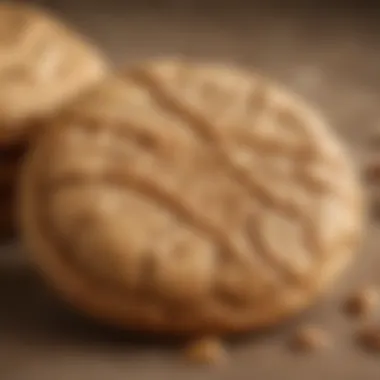
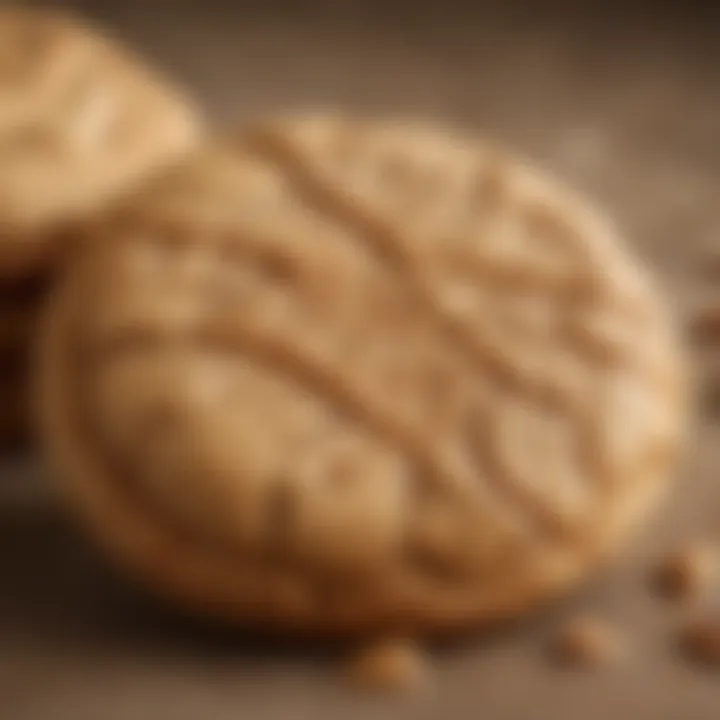
Types of Peanut Butter
Peanut butter is the star player in any cookie recipe. It's not just a flavor; it’s the foundation upon which the rest of the cookie is built. There are several types of peanut butter available, each with distinct characteristics that can alter the cookie's taste and texture.
- Creamy Peanut Butter: This classic option is commonly found in kitchen cupboards everywhere. With its smooth texture, it creates a cookie that is rich and luscious. The creamy variety blends easily with other ingredients, ensuring even distribution for a perfectly unified flavor.
- Chunky Peanut Butter: This type adds a delightful crunch, giving the cookie an unexpected twist in texture. The bits of peanut create a robust mouthfeel, making each bite an adventure. However, this can lead to uneven mixing if not handled properly.
- Natural Peanut Butter: Made with minimal processing, this option contains oil on the surface that needs mixing. When used, it might give a more pronounced peanut flavor, but can also lead to a drier cookie if not calibrated right with other wet ingredients.
Flours to Consider
Choosing the right flour is like picking the right canvas for painting; it sets the stage for the masterpiece to come. Each type contributes something unique, and understanding them can lead to better cookie outcomes.
All-purpose flour
All-purpose flour is the chameleon of the baking world. It handles a bit of everything, making it an ideal choice for peanut butter cookies. Its moderate protein content provides the necessary structure while maintaining a tender bite. It’s easily accessible and can be found in nearly every kitchen. This versatility makes it the go-to option for many bakers, ensuring reliability in both flavor and texture.
Gluten-free options
For those avoiding gluten, gluten-free flours have come a long way, offering a variety of choices. Almond flour, coconut flour, and oat flour are popular options. They provide unique flavors and a denser texture. However, they often require adjustments in liquid ratios, so careful experimentation is vital. These options are helpful for creating a cookie that doesn’t sacrifice taste or texture while catering to dietary needs.
Whole wheat flour
Whole wheat flour serves as a heartier alternative to white flour. It brings a nutty flavor that complements peanut butter beautifully. The added fiber from the whole grain makes for a more nutritious cookie, which might appeal to health-conscious bakers. However, its higher protein content can lead to a denser texture, potentially compromising that classic chewy quality unless balanced with other ingredients.
Sweeteners and Their Roles
Sweeteners do more than just add flavor; they also influence texture and moisture in cookies. The choice of sweetener can elevate a simple cookie into something extraordinary.
Granulated sugar
Granulated sugar is the old trusty sidekick in baking. It sweetens without imparting additional flavors, which is crucial for peanut butter cookies where the nutty essence should shine through. It helps with browning while providing a crisp texture. However, using it alone can lead to a cookie that is too dry, so it often pairs beautifully with other sugar types.
Brown sugar
Brown sugar, thanks to its molasses content, introduces moisture and depth. This sugar caramelizes, allowing cookies to develop richer flavors and a delectable chew. When combined with granulated sugar, it can produce a well-rounded cookie that is both tender and flavorful. However, overusing it may lead to cookies that are too soft and might fall apart easily.
Natural sweeteners
Natural sweeteners like maple syrup or honey bring their unique profiles into play. These alternatives are generally less processed and can add a complexity of flavor. Using them can result in a cookie that offers an unusual taste experience and a touch of moisture. Nevertheless, care must be taken to adjust other liquid ingredients, as they can alter the consistency of the dough.
"In baking, it’s not just about sweetness; it's about creating a symphony of flavors that dance together, leading to a delightful treat."
The synergy among these ingredients is what turns simple peanut butter cookies into a delightful experience. By carefully selecting and understanding how each ingredient interacts, aspiring bakers can craft cookies that are not only tasty but also tailored to their individual preferences.
Preparation Techniques
The preparation techniques you employ while making peanut butter cookies can significantly influence the final outcome. It's not just about throwing ingredients together; how you mix, chill, and bake can make all the difference in texture and flavor. Understanding these techniques allows for a more controllable and enjoyable baking experience. It’s about taking the art of baking and applying a personal touch, ensuring each batch of cookies meets your standards perfectly.
Mixing Methods
Creaming method
The creaming method is a cornerstone of baking, particularly for cookies. This technique involves beating sugar and fat—typically butter and peanut butter—together until the mixture becomes light and fluffy. What’s crucial here is the incorporation of air, which helps to create a tender cookie with a delightful crumb. This method is often favored not just for the outcome but also because it’s relatively straightforward.
One key characteristic of the creaming method is the necessity of using softened butter. This prepares the fat to blend smoothly with the sugar, allowing for better air retention. When done right, you’ll find that the cookies expand beautifully in the oven.
However, there are a few aspects to keep an eye on. You’ll want to ensure you don’t overmix after adding the eggs and dry ingredients; this can lead to cookies that are tough instead of soft. Overall, the creaming method remains a popular choice for its effectiveness in producing cookies that have not only structure but also a melt-in-your-mouth quality that many peanut butter cookie lovers adore.
One-bowl technique
On the other end of the spectrum, there’s the one-bowl technique, which streamlines the baking process considerably. This method essentially brings all your ingredients together in a single bowl, requiring less clean-up and a more laid-back approach to baking. It's particularly appealing to busy home cooks or those not looking to fuss about multiple bowls and utensils.
The beauty of the one-bowl technique lies in its simplicity. You mix your peanut butter, sugars, and eggs together first, then fold in dry ingredients without the fuss of traditional mixing methods. Its unique feature is that it promotes a slightly denser cookie, which some bakers actually favor. However, caution is warranted; you need to mix thoroughly enough to avoid clumps of flour while still not risking overmixing, which could toughen the dough.
In short, the one-bowl method offers a balance of ease and satisfying results. It may lack the airiness of the creaming method, but it's a solid choice when you're eager to whip up a batch quickly.
Chilling Dough
Chilling your dough serves as a foundational technique for many cookie recipes, including those peanut butter gems. The main idea is that it firms up the fats, allowing for better control over how your cookies spread while baking. It’s a tip that many may overlook, but it can severely impact the outcome of your batch.
When you chill the dough, you’re also enhancing the flavors. As the dough rests, the ingredients meld together, developing a richer, more harmonious flavor profile. You might think that skipping this step is harmless in the whirlwind of baking, but it can lead to the cookie becoming flatter than a pancake, losing that chewy and soft finish that’s a hallmark of peanut butter cookies.
Also, chilling allows more time for the flour to hydrate, which creates a more cohesive dough. If you’re pinched for time, consider chilling the dough for just 30 minutes; it’s better than none at all.
"A little patience can mean the difference between a bland cookie and one that bursts with flavor!"
Incorporating these preparation techniques empowers bakers to cultivate their skills, whether it's mastering the creaming method or mixing quickly with a one-bowl approach. With a deeper understanding of how these techniques alter the final product, your peanut butter cookie game is bound to improve.
Classic Peanut Butter Cookie Recipe
The classic peanut butter cookie recipe serves as the cornerstone of any peanut butter cookie enthusiast's repertoire. It’s the rhythm that sets the mood in the kitchen, providing both simplicity and a canvas for creativity. The beauty of this recipe lies not just in its taste but also in the process. With just a handful of basic ingredients, you can create a comforting cookie that evokes warm memories and satisfies cravings. The recipe is essential because it forms the foundation for variations, adaptations, and even new inventions in the world of baking. Furthermore, it helps cooks connect with their roots and traditions, making it a cultural touchstone that transcends generations.
Step-by-Step Guide

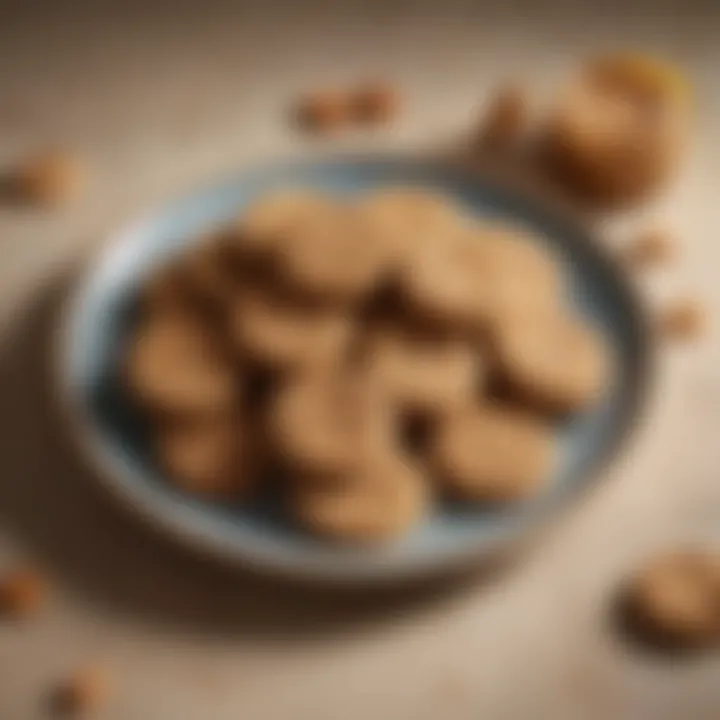
To navigate the world of baking these delightful treats, one must follow a well-laid plan. Here’s a straightforward breakdown of how to whip up a batch of classic peanut butter cookies:
- Gather Your Ingredients:
- Preheat Your Oven: Set it to 350°F (175°C). A preheated oven is essential for even baking.
- Mix Wet Ingredients: In a bowl, blend the peanut butter, sugar, egg, and vanilla extract until smooth. This step activates the flavors and ensures everything melds well.
- Form the Cookies: Using a spoon or a cookie scoop, drop dollops of dough onto a baking sheet lined with parchment paper. Space them out as they will spread while baking.
- Create the Signature Crisscross Pattern: Lightly press the back of a fork into each cookie, creating a distinctive pattern that not only looks appealing but also allows for even cooking.
- Baking: Place the tray in the oven and bake for about 10-12 minutes, or until the edges start to turn golden brown. It’s better to err on the side of slightly underbaked, as cookies will continue to cook slightly on the tray after they’re taken out.
- Cooling: Let the cookies rest on the baking sheet for about five minutes before transferring them to a wire rack. This helps them firm up and maintain their tried-and-true texture.
- 1 cup peanut butter
- 1 cup granulated sugar
- 1 egg
- 1 teaspoon vanilla extract
- Optional: a pinch of salt for balance
By following these steps, you delve not just into baking but into a methodical approach that many home cooks treasure.
Baking Time and Temperature
Baking time and temperature can be the make-or-break factors in achieving that perfect peanut butter cookie. Too long in the oven or too high of a temperature can turn a delightful cookie into a dry disk of disappointment. For best results, keep these considerations in mind:
- Temperature: A consistent oven temperature of 350°F ensures that the cookies bake evenly. Besides, a too-hot oven might lead to burnt bottoms while leaving the centers gooey.
- Timing: Cookies usually take about 10 to 12 minutes to bake. However, every oven has its own personality, so it’s wise to start checking for doneness around the 8-minute mark. They should be just set and a little soft in the center.
- Visual Cues: Look for that golden edge but still soft center; also, they should slightly puffed and have cracks on the surface. This is a sign (or a ticket) to pull them from the oven.
Remember, while recipes offer guidelines, the art of baking is all about adjusting to what works best in your kitchen. It’s about learning to listen to the smells, the sounds, and the looks of your baking creations.
"Baking is both a science and an art. Knowing when to trust your instincts is the secret recipe to perfection."
With this classic peanut butter cookie recipe in your arsenal, you have a reliable method for crafting cookies that bring comfort and satisfaction in every bite.
Variations and Adaptations
Variations and adaptations in peanut butter cookies are edge tools that ensure everyone can savor a piece of this delightful treat. For the home cook, understanding how to tweak the basic recipe opens a world of flavor and choice. Each alteration provides unique flavors, textures, and appeal to different dietary requirements. Embracing these variations allows you to cater to tastes and preferences, whether that means throwing in a handful of chocolate or making the cookies vegan. These adaptations greatly enhance the baking experience, inviting creativity in the kitchen.
Add-ins and Mix-ins
Chocolate chips
Adding chocolate chips to peanut butter cookies is like a cherry on top. It’s a classic pairing, bringing together the rich, creamy flavor of peanut butter and the lusciousness of chocolate. The sweetness of chocolate chips can balance the nutty flavor, creating a cookie that is sure to satisfy any sweet tooth. Not only do they provide a nice contrasting color, but they also melt beautifully, creating pockets of gooey goodness.
Yet, one must consider chocolate chips' caloric content. While they enhance flavor, they can also add extra sugar, which may not suit all diets. Additionally, those sensitive to chocolate flavors might find it overwhelming. However, for most, chocolate chips are an indispensable addition, transforming a homely cookie into something special.
Nuts and seeds
Incorporating nuts and seeds into peanut butter cookies is another smart move. They offer a delightful crunch that contrasts the softness of the cookie. Almonds, walnuts, or sunflower seeds can deepen the complexity of flavors and elevate the overall texture. Nuts not only add richness but also come packed with essential nutrients and healthy fats.
On the flip side, allergies are something to be mindful of. Many people have nut-related allergies, which can pose a real risk when baking for a crowd. Thus, while they are a wholesome addition, it’s wise to check in with your guests beforehand.
Fruits
Fruits make for an unexpected yet delightful addition to peanut butter cookies. Think dried cranberries, raisins, or even chopped apples mingling with that nutty batter. They impart natural sweetness and moisture, which can create a softer cookie. Fruits can also make the treat feel more wholesome—who doesn’t love sneaking in a bit of fiber with their dessert?
However, fresh fruits could change the cookie's texture, causing them to spread more than typical. Dried fruits have the advantage of preserving their shape and providing a concentrated burst of flavor. While fruit may not be the first thought when one considers peanut butter cookies, their addition creates a unique twist that is worth exploring.
Dietary Modifications
Vegan substitutes
For those leaning towards a plant-based lifestyle, vegan substitutes are a true lifesaver. Ingredients like flaxseed meal or applesauce can effortlessly replace eggs, while replacing butter with coconut oil or nut-based spreads can maintain the beloved richness of peanut butter cookies. These ingredients contribute to moist and flavorful cookies without the dairy.
One unique feature of vegan substitutes is their broader appeal. More people are making dietary shifts, so having a recipe on hand that everyone can enjoy makes such an impact. A potential drawback, though, is that some may feel that texture or taste might slightly vary from the traditional version. Nevertheless, these adaptations allow more folks to indulge without compromise.
Low-sugar options
Reducing sugar but still enjoying peanut butter cookies is a balance that many seek. By using natural sweeteners like honey or coconut sugar, it is possible to craft a healthier treat. These alternatives often come with additional health benefits while still maintaining some level of sweetness.
The foremost advantage here is health-conscious eating, which increasingly resonates with many. Yet, achieving the perfect sweetness in baked goods might be a little tricky. There can be trial and error involved as these sweeteners have different sweetness levels compared to granulated sugar. Some bakers might feel they lose that classic cookie taste when cutting back on sugar, but it is very doable with the right know-how.
Gluten-free adaptations
For those who need to avoid gluten, gluten-free adaptations have come a long way. Options like almond flour or oat flour can mimic all-purpose flour in peanut butter cookies, often adding a nutty background flavor that complements the peanut butter.
The key characteristic of gluten-free adaptations is their ability to maintain texture. It prevents the cookie from becoming too dry or crumbly. Nevertheless, not all gluten-free flours are equal, and some experimentation may be necessary to get the ratios just right. However, the joy of sharing a delicious cookie with friends who follow this diet can be immensely rewarding, fostering inclusiveness in baking.
Common Pitfalls in Baking
When it comes to baking peanut butter cookies, overcoming common pitfalls can make a world of difference in the final product. Knowing what can sour the experience—like overmixing the batter or misjudging baking time—can save your cookies from becoming too tough or too doughy. In this section, we delve into these pitfalls, offering insights that not only uplift your baking game but also help you to achieve that desired balance of flavor and texture.
Overmixing vs. Undermixing
Finding the right balance when mixing your dough is crucial. On one hand, overmixing can lead to cookies that are dense and dry. When flour is overworked, gluten develops more than it should, creating a tough texture rather than the melt-in-your-mouth softness that peanut butter lovers crave. A typical sign of overmixing is a dough that looks overly smooth and elastic.
On the other hand, undermixing can leave you with a lumpy batter where some ingredients don’t get incorporated properly. The cookies might end up with pockets of flour or sugar that don’t dissolve, resulting in uneven sweetness and texture. The rule of thumb here is simple: mix just until all ingredients are combined. If you see bits of flour, that’s usually fine; they will integrate during baking.
Misjudging Baking Time
Baking time can make or break your peanut butter cookies. It’s a fine line between perfectly baked and burnt. If you pull your cookies out too early, you may end up with doughy centers that don't fully set, leaving you with an undesirable texture. Conversely, leaving them in the oven for too long can result in dry, crumbly cookies.
To avoid such fumbles, watch the clock but also rely on your instincts. The edges of the cookies should be slightly golden but the centers may still appear soft. A good tip is to remove them from the oven just as they start to show a hint of color; they will continue to cook on the baking sheet from residual heat. Setting a timer or using your sense of smell can guide you as well—when you start to catch a whiff of those delicious cookies, it’s usually time to check them.
"Patience is key—sometimes even the best recipes require a watchful eye for that perfect bake."
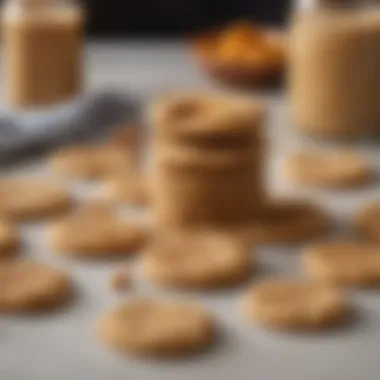
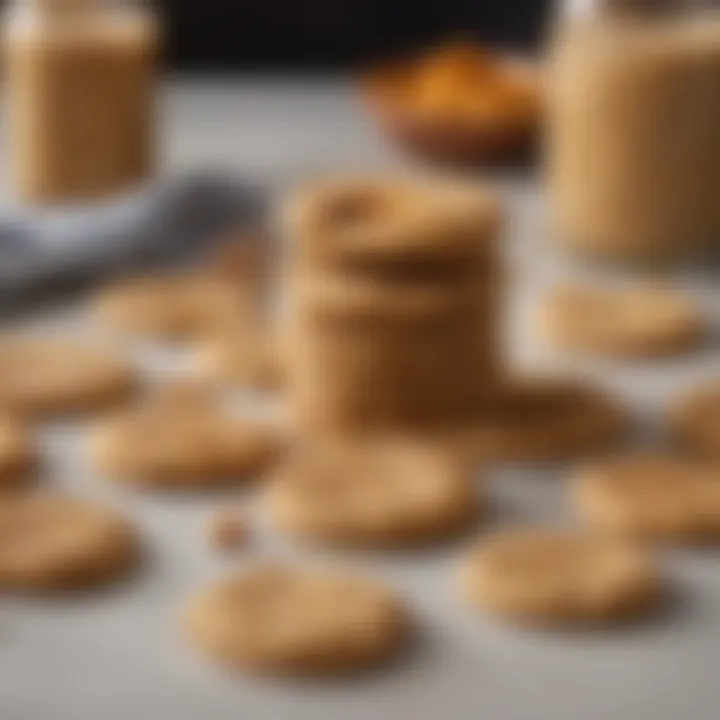
Arming yourself with an understanding of these common pitfalls can elevate your peanut butter cookie-making efforts from mundane to exceptional. By steering clear of overmixing and carefully monitoring your baking time, you’ll be well on your way to achieving the ideal cookie every time.
Presentation and Serving Suggestions
When it comes to peanut butter cookies, presentation isn't just an afterthought; it plays a significant role in the overall experience of enjoying these treats. Engaging the eyes can often heighten expectations and amplify the pleasure derived from a well-baked cookie. Beautifully plated cookies can transform a simple snack into a delightful dessert, making it suitable for various occasions—from casual family gatherings to formal affairs. Considering how you present cookies can enhance their appeal and show the care put into making them.
Moreover, there's a tactile element involved. The way cookies are arranged on a plate or served alongside certain accompaniments can draw attention and provoke curiosity. Paying attention to detail encourages a connection between the baker and the consumer, allowing both to appreciate the art involved in baking.
Plating Techniques
Plating isn’t just the icing on the cake; it’s the whole display of flavors and textures that can elevate the cookie from basic to extraordinary. Here's how to make your peanut butter cookies shine:
- Use different heights: Layer cookies in stacks or arrange them at varying heights to create visual interest.
- Garnish smartly: Consider a sprinkle of sea salt or crushed peanuts atop your cookies for a pop of color and an extra hint of flavor.
- Play with shapes: Use cookie cutters to give your cookies fun shapes, especially for occasions like birthdays or holidays. The unexpected shapes can surprise and delight.
Ultimately, the goal is to create a presentation that not only looks appetizing but also reflects the essence of your cookies.
Pairings with Beverages
Beverages can significantly enhance the experience of enjoying peanut butter cookies. They complement the flavors, temperature, and even texture, making each bite more satisfying.
Coffee
Coffee pairs beautifully with peanut butter cookies, thanks to its boldness that stands up to the rich, nutty flavors of the cookies. A strong espresso can cut through the sweetness, leaving a pleasant aftertaste. Moreover, the warm, aromatic scent of coffee can amplify the cookie's enticing aroma, creating a well-rounded sensory experience. One unique feature of coffee is its ability to bring out the roasted notes in the peanuts, enhancing the overall flavor. However, be cautious about the balance; too much bitterness from an over-extracted brew can overshadow the delicate sweetness of the cookie.
Milk
Milk and cookies are classic for a reason. With its creamy texture and mild sweetness, milk complements the rich, dense nature of peanut butter cookies perfectly. The contrast between the warm cookie and cold milk creates a delightful sensation. What's more, milk serves to soften the cookie, making it easier to indulge in. This pairing is particularly appealing for families and those looking for a nostalgic comfort food experience. However, while whole milk adds richness, lighter alternatives like almond or oat milk can provide a unique twist, introducing new textures and flavor profiles.
Tea
Tea offers a lighter, yet equally enjoyable alternative to coffee and milk when it comes to enjoying peanut butter cookies. A soothing chamomile or a robust chai can both provide a delightful backdrop to the rich flavors of the cookies. The floral notes in chamomile can present an interesting contrast to the earthiness of peanut butter, while the spices in chai can enhance the cookie’s nutty qualities. However, one should be careful with the temperature; overly hot tea may cause the cookies to lose their ideal texture if dunked.
Finding the right beverage pairing can elevate your peanut butter cookies from delicious to divine. Experiment to discover your favorite combinations.
Storage Tips
Understanding how to properly store peanut butter cookies is crucial for keeping their flavor and texture intact. Many home bakers might not realize that the way cookies are stored can greatly affect their quality over time. Peanut butter cookies, with their rich and nutty flavor, deserve the best treatment, especially if they've been made in a big batch or for a special occasion.
Room Temperature vs. Refrigeration
Storing peanut butter cookies at room temperature can be the simplest method when it comes to short-term storage. Here are some considerations:
- Ideal Environment: Cookies should be kept in an airtight container. A metal tin can do wonders to maintain their moisture. Stashing them in open air can lead them to becoming stale or overly dry.
- Timeframe: Generally, they’ll stay fresh at room temperature for about a week. After that, they might start showing their age.
- Humidity Caution: If it's particularly humid, it might be wise to consider refrigeration, but be warned: chilling can change the texture, making them a bit chewy.
Refrigerating cookies is more about preserving freshness rather than enhancing taste. They can last for two to three weeks in the fridge if they've been properly wrapped. Just be sure to let them return to room temperature before serving for the best flavor!
Freezing Peanut Butter Cookies
When it comes to long-term storage, freezing is a fantastic option. If you've baked a large batch and want to save some for later, follow these simple steps:
- Cool Cookies First: Make sure your cookies are completely cool before attempting to freeze them. This prevents condensation, which can lead to sogginess.
- Wrap Them Well: Individually wrap the cookies in plastic wrap, or you can also use aluminum foil. After that, place them in a freezer bag. Expelling as much air as possible helps avoid freezer burn.
- Label and Date: Being organized goes a long way. Label your containers or bags with the date, so you know how long they’ve been in the freezer.
Freezing peanut butter cookies allows them to maintain their signature taste for several months, usually up to three. When you’re ready to indulge, just take them out of the freezer, allow them to thaw at room temperature, and enjoy!
"Properly stored, these delightful treats can remain a sweet surprise, transforming an ordinary day into something special!"
Culinary Trends
Culinary trends shape the way we approach food and cooking, turning the conventional into the contemporary and elevating our kitchens to innovation hubs. In the realm of peanut butter cookies, understanding these trends is like having your finger on the pulse of the culinary world. This section aims to navigate through these shifting tides, showcasing their relevance to our beloved cookies.
Peanut Butter in Contemporary Desserts
Peanut butter has made a remarkable resurgence, not just as a spread for sandwiches, but as a star ingredient in a myriad of desserts. Today’s food lovers are eagerly experimenting, blending traditional recipes with modern flair. Today, peanut butter cookies are no longer standalone creations but often find themselves cozying up to flavors and ingredients such as chocolate, caramel, or even spice mixes like cinnamon and cayenne.
Consider a creamy peanut butter mousse layered with a rich chocolate ganache. Such desserts invite creativity and personalization, pricking the curiosity and excitement of home bakers. You can easily infuse your twinkling ideas into classic recipes, making them your own.
Some notable trends include:
- Peanut Butter Swirl Brownies: Combining the richness of brownies with the nuttiness of peanut butter.
- Peanut Butter Vegan Cookie Dough Bites: A health-conscious take, swapping traditional ingredients for plant-based choices.
- Stuffed Peanut Butter Cookies: Incorporating fillings, like nutella or dark chocolate nuggets, adds a surprise in every bite.
This enveloping trend not only caters to diverse palates but also meets growing demands for health-conscious and gourmet desserts. It reinforces that peanut butter is not just a nostalgic ingredient but a versatile one.
Sustainability in Peanut Procurement
As we merge culinary creativity with responsible eating, sustainability takes center stage. This trend encourages consumers and chefs alike to rethink ingredient sourcing, especially for staples such as peanut butter. How we procure peanuts impacts not just our communities but also the environment.
When seeking out peanut butter for baking—be it considering organic options or local sources—it’s essential to ask:
- Where do the peanuts come from?
- Are they grown using methods that are environmentally friendly?
Here are some noteworthy considerations in this trend:
- Support Local Farmers: Buying from nearby farms not only reduces the carbon footprint associated with transportation but also supports local economies.
- Organic Farming Practices: These methods often promote biodiversity, healthier soil, and can reduce dependency on petrochemicals.
- Fair Trade Certification: Look for products that guarantee fair wages and working conditions for farmers, ensuring that the benefits of peanut trade reach those who grow them.
By embracing these practices, bakers contribute to a sustainable food system while indulging in their love for peanut butter. The way we integrate these principles into our baking not only enhances the quality of our treats but also reflects a conscientious approach to culinary creativity, marrying taste with responsibility.
"The path to a delicious peanut butter cookie is paved with a commitment to quality ingredients and ethical practices. Each bite should reflect not just flavor, but also a well-informed choice."







